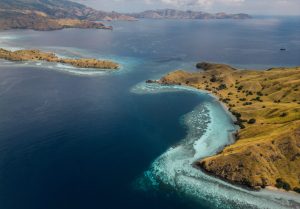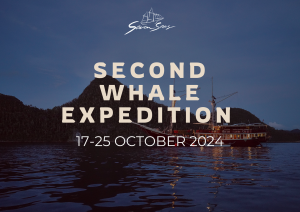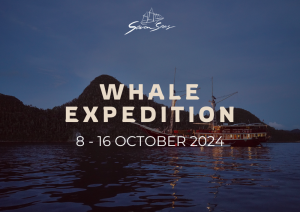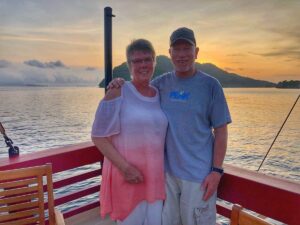Trip report by Tony Pigott. Photos and manta video by David Pincus. Banda video by Linda Johnston.
Raja Ampat Diving Trips offer an extraordinary experience in Paradise on the Edge, leading you to the stunning Spice Islands. This journey introduces divers to the world-famous underwater beauty of Raja Ampat. It was day three anchored just off the coast of West Papua in the idyllicRaja Ampat Diving Trips bring divers to Paradise on the Edge and the Spice Islands, home to world-famous underwater beauty. On day three aboard the Seven Seas, we witnessed an unforgettable moment: an immense ocean manta gliding above us, followed by a trio of black rays drifting past like silent shadows.
Raja Ampat Diving Trips bring divers to Paradise on the Edge and the Spice Islands, home to world-famous underwater beauty. On day three aboard the Seven Seas, we witnessed an unforgettable moment: an immense ocean manta gliding above us, followed by a trio of black rays drifting past like silent shadows.
During Raja Ampat Diving Trips, divers can encounter majestic mantas, black rays, and an incredible variety of marine life. Each dive promises unforgettable moments in the crystal-clear waters of Raja Ampat. I defy anyone to see this and not feel a rush of awe and anxiety in equal measure. How could such creatures exist? How long do they have? And what is the future for this corner of the world; the Coral Triangle, home to more than 400 coral and 600 fish species; a migratory route for whales and turtles and big pelagic; the Amazon of the ocean in the words of UNESCO? An encounter with Mantas shakes you up. It forces you to look around and ask questions.
The big picture is not pretty. According to the UN, 90 percent of the world’s fisheries are depleted or facing collapse. Coral forests are bleaching across Australia’s Great Barrier Reef because of warming water. So, what of this remote ocean treasure chest? Is there any hope even on a small scale?
The next day I had a close call with baby Black Tip Sharks in the Misool Eco Sanctuary, a marine zone protecting 5% of Raja Ampat. At Arborek, we met young researchers from Barefoot Conservation studying reefs and mantas. Seeing baby sharks and local collaboration was encouraging, though questions remain if it’s too late.
In Misool, towering karst islands rise from indigo waters where we kayak through lagoons alive with rays and orchids on sheer cliffs. Hidden in a cave settlement, we discovered ancient paintings of ocean life, proof that people have fished here for thousands of years.
ockface studded by stalactites and blackened by fire. Across the wall are two ochre coloured cave paintings of ocean life – a giant shrimp and what looks like a trevally…
Australian aborigines once used these caves, drawn by the rich seas. At “Too Many Fish,” fusiliers swarm in the shadows while wrasses and barracudas patrol nearby. But rising demand across Asia has led to overfishing, with trawlers scouring Indonesia’s waters. Even locals now send giant groupers from Seram to Hong Kong and beyond within hours.
Don’t miss the chance to join Raja Ampat Diving Trips with Seven Seas. This adventure is more than just a journey—it’s a diving experience you will cherish forever.
Why Choose Raja Ampat Diving Trips?
Raja Ampat Diving Trips offer an unmatched underwater paradise. With crystal-clear waters, vibrant coral reefs, and rare marine species, it’s a dream destination for divers seeking adventure and beauty in one journey.
Best Spots for Raja Ampat Diving Trips
From the iconic Cape Kri to the colorful reefs of Misool, Raja Ampat Diving Trips bring you to world-class dive sites. Each spot is filled with manta rays, schools of fish, and breathtaking coral gardens that amaze every diver.
Unforgettable Experiences with Raja Ampat Diving Trips
Beyond diving, Raja Ampat Diving Trips give you unforgettable moments — stunning sunsets, island hopping, and encounters with local culture. Every trip is more than a dive; it’s a once-in-a-lifetime adventure.
To avert disaster local government, the Seven Seas, nearby villagers and a bank account of the traditional kind have come together to try and establish a conservation zone around Grogas. Can it work? Are the best solutions for restoring the oceans bottom up? – no pun intended; community led conservation solutions that can establish a balanced and sustainable fishery and livelihood, healthy reefs, sustainable catches, extraordinary diving and the revenues it attracts? Can “local” resist the forces of “big”, distant markets and powerful, profit hungry business?
The final leg took us to Banda Neira, once the epicenter of the global nutmeg trade and colonial conflict. Its history of wealth and bloodshed contrasts with today’s quiet villages, colorful bungalows, and drying nutmeg—where the Dutch once even traded Rhun for Manhattan.
Banda, once marked by colonial rule, now reflects resilience through Mohammed Hatta’s legacy. Today, its islands lead with marine conservation, sustainable fishing, and community-driven protection efforts.
Then there is nature itself. One of our last and most dramatic dives is at the foot of Gunung Api. Fire mountain. On May 19, 1988 the mountain erupted sending an avalanche of lava into Banda’s harbor completely destroying 70,000 square metres of coral reef. Today, the mountain side to the water’s edge is still a massive pile of black rubble. But underwater, to the amazement of marine scientists, the coral rebounded not in 70 years as estimated but in five. And grew out with greater diversity and size than nearby reefs that were untouched by the eruption. To a very lucky and spoiled diver, the effect is mesmerizing. To a citizen of this planet, it feels like hope.
Link Schedule
Tony Pigott
November 2017
NOTE :
To reserve your spots or see available trips, please check out our schedule page :
Schedule & Availability
Please also don’t hesitate to reach out to us at [email protected] should you require any further information or need recommendations for accommodation or flights etc. Our reservation team would be more than happy to assist. Cheers!





